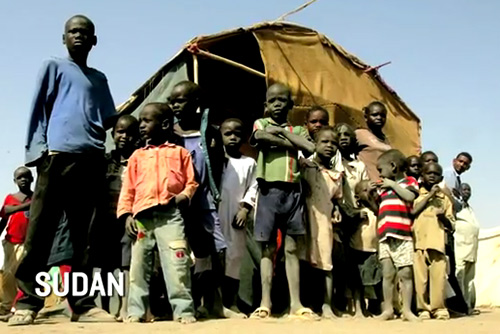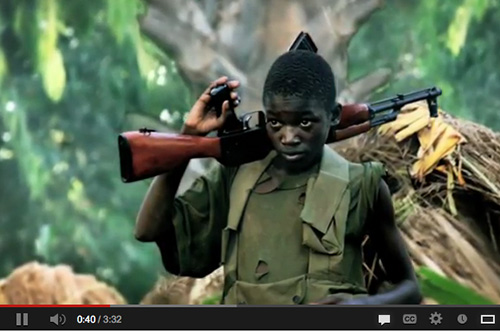The following was first published @ http://news.harvard.edu/gazette/story/2013/03/the-clip-that-stirred-a-cause-perhaps/ and has been submitted by the author:
A Ugandan boy speaking almost perfect English struggles to maintain his composure as he discusses his brother, who was kidnapped and killed by the Lord’s Resistance Army (LRA), a militant group led by indicted war criminal Joseph Kony.
“We may meet in heaven,” Jacob Acaye says of his brother. He bows his head, covering his face with both hands, and begins to cry uncontrollably. A man’s reassuring voice is heard: “It’s OK, it’s OK.” He makes a promise to the sobbing boy, “We’re going to stop them.”
Later, another boy, Gavin Russell, blond and smiling, sits in front of the same man — his father, Jason — as he slides a photograph of Kony across a table. “Can I tell you the bad guy’s name?” Jason Russell says. He pushes the photo closer. “Joseph Kony takes children from their parents and . . . makes them shoot and kill other people.”
Gavin looks up from the photo, wide-eyed. “It’s sad,” he says. His father makes another promise: “We are going to make Joseph Kony a household name to bring his crimes to the light.”
These two scenes come from “Kony 2012,” a documentary that has been viewed online more than 100 million times. Directed and narrated by Russell, the co-founder of the nonprofit Invisible Children, the 30-minute film was launched last March and instantly became a social media sensation.
The documentary “Kony 2012″ has been viewed online more than 100 million times. Devanesan uses the video to pose this question: What lessons does “Kony 2012” hold for social justice advocates?
Russell’s goal was clear: to raise awareness among young Americans about Kony’s crimes, which include the kidnappings of tens of thousands of children whom he forced to become soldiers and sex slaves, and build a community that wanted to see him arrested and tried for war crimes. However, critics said the video simplified the conflict in Uganda, and misled visitors to the site about the true demands of activism.
Do mouse clicking and video sharing count as legitimate forms of grass-roots mobilization?
Berkman Center Fellow Ruha Devanesan has been researching the “Kony 2012” campaign and its lessons. As executive director of the Internet Bar Organization, a nonprofit working to improve access to justice through technology, Devanesan has also led the design and implementation of several tech-focused social justice initiatives. She discussed her work on “Kony 2012” during a Feb. 19 talk at the Berkman Center (video here) and also in an interview with the Gazette.
The first step toward momentum is generating engagement, said Devanesan.
“You have to make the issue relevant to [people] somehow,” she says, “Invisible Children managed to take an issue far removed from the 14- to 25-year-old target segment and make it personally relevant.”
As for the critique that the video simplified the conflict, Devanesan responded, “there has to be an entryway” to an issue; simplicity and emotion are two ways to open the door.
Social justice campaigns seldom work through data-driven appeals to the intellect, so nonprofits often appeal to emotions, Devanesan said.
“Amnesty International, for example, ran a series of short videos on torture. Those were more about using shock and fear as the emotional draw, as opposed to ‘Kony 2012,’ which uses empathy and sadness. Both appeal to emotions, just different emotions.
A year later, it remains unclear whether “Kony 2012” has created a new template for leveraging social media. “If someone went out today and tried to replicate ‘Kony 2012,’ it would probably fail, because people have seen it already,” Devanesan said. Image from “Kony 2012″
“The sweet spot lies somewhere in the middle,” she said, between appeals to emotion and providing more deep-dive information. “It might be that ‘Kony 2012’ simplified too much. Using a cute little kid in your video is like using a cat in your video. It pulls people in, because it’s endearing and charming,” but doesn’t provide much context.
So what lessons does “Kony 2012” hold for social justice advocates?
“The basic lessons are to simplify your message as much as you can without misrepresenting it, and to find a way for people to connect with it,” she said. “There’s also a need to create gateways in order for people to connect more substantively.”
Written By Chuck Leddy
Email: ChuckLeddy@comcast.net
Follow Chuck Leddy on Twitter at @BostonBkCritic
The content and legality of the submission is the sole responsibility of the user responsible for submission. Submitted content does not reflect the views of Social Justice Solutions Inc. and has been posted in accordance with SJS’s terms of service and privacy policy.
Sources:
Our authors want to hear from you! Click to leave a comment
Related Posts








